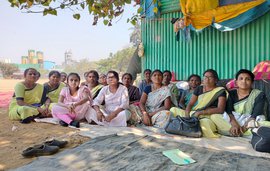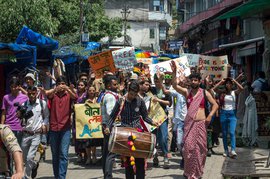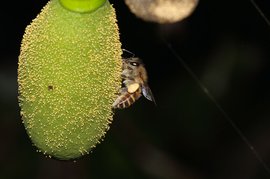“One small mistake and you will get a sattur instead of koyta! ” Rajesh Chaphekar would know the difference between a butcher’s knife and a sickle. A master lohar (blacksmith), he has crafted more than 10,000 iron tools at his workshop in Actan village in Maharashtra.
The 52-year-old learnt from his father, Dattatrey Chaphekar, and belongs to a long line of panchal lohars who have enjoyed the loyalty of their customers from among the farming community in Maharashtra. “People would say, ‘ Actan se hi hatyar leke aao’ [Get the tools only from Actan],” says this seventh generation blacksmith in Vasai taluka . He can make more than 25 different farm tools.
Customers came from as far as Uran in Navi Mumbai – roughly 90 kilometres away, to place bulk orders for tassni , a tool that was crucial in the making of boats. “ Girhaiks [customers] would stay at our house for four days and observe us making the tool from scratch,” he recalls.
The narrow lanes in Actan village have been traditionally demarcated on caste-based occupations: sonar (goldsmith), lohar (blacksmith), sutar (carpenter), chambhar (cobbler) and kumbhar (potter). People in the village say they have always been disciples of Vishwakarma, a popular deity of craftspeople. Panchal lohars are listed under Nomadic Tribes since 2008, before which they were classified as OBC (Other Backward Classes).
Rajesh says he had no
intention of continuing his family's blacksmithing tradition when he turned 19.
His job as a storekeeper in an electronics shop where he was working, fetched him Rs. 1,200 a month. It was a few years later that a fallout in the larger joint family
left his father without work, forcing him –the eldest son –to join the family
trade.


Rajesh Chaphekar, a blacksmith in Vasai taluka's Actan village with a sickle (left) made by him. He learnt the craft from his father Dattatrey Chaphekar, whose photo he is holding (right)


Rajesh's w orkshop (left) is close to the popular Actan cross (right), which leads to the lane where only lohars once lived
Now three decades later, he is a master blacksmith. His workday starts after 7 a.m. and he goes on for the next 12 hours, and he stops every now and then for a quick tea break. In a day he can craft up to three tools. His customers include the Adivasis of Benapatti who live near Bhuigaon in Vasai, and others in Gorai village of Mumbai.
Some of his bestsellers include the koyta (small sickle), morli (vegetable and meat cutting tool), aaut (plough) , taasni ( adze ) , kaati (fish cleaver) , chimtey (tongs) and sattur (cleaver/butcher’s knife).
Rajesh also makes customised tools as he says, “every village has their own design and requirements. The toddy tappers require extra grip to hold their koytas [small sickle] firmly while climbing trees.” Banana and coconut cultivators send across their tools to sharpen and repair through the year.
“We keep receiving gifts in return,” he says, showing fresh coconuts gifted by a local cultivator as a token of appreciation for sharpening his sickle . “ When I repair a kaati [fish cleaver] the Koli brothers sometimes bring us the day’s fresh catch," adds Rajesh.
He also receives several orders all the way from Wagholi in Pune because there are very few blacksmiths in that area. “ Tyanche sattur astat, bakre kapayla [Their order consists of butcher’s knives to cut goat meat].”
Keen to innovate,
Rajesh has crafted a special sickle designed to ease the cutting of the hard dry coconuts, “I keep experimenting. But I will not show it to you. It’s my patent!” he says smiling, and he doesn’t allow any photos.


Rajesh can make more than 25 different types of tools (left), many of which he innovates for his customers (right) after understanding their requirements


Sonali Chaphekar, Rajesh's wife holds a traditional morli used to cut vegetables and fruits (left). For elderly women who can't sit on the floor, Rajesh has designed a compact morli that be attached to the kitchen platform (right)
Among the fastest selling items is a morli , a compact vegetable cutter that can be fixed onto kitchen platforms. It is particularly useful for the elderly who find it challenging to use the larger, traditional floor-based ones.
During the monsoon months as farmers head out for daily wage work in the city, sales drop. “Sometimes I earn Rs. 100 a day and some days only Rs. 10. Sometimes I may get Rs. 3,000 or 5,000 and the next day again nothing. I cannot predict,” he says, describing his earnings. “Girhaik aani maran kadhi yetil kaai saangta yeta ka? [Can you ever predict when the customer or death will knock on your door?]."
*****
Every morning, including Sundays, Rajesh fires his bhatti (forge).
The day PARI visits, as he waits for the forge to heat up, a local turns up with a potato. No words are exchanged. Rajesh takes the potato and buries it in a small section of the forge. “He loves coal-roasted potatoes and will pick it up in an hour," he tells us.
Soon the day's first customer arrives and hands him four sickles to sharpen. He pauses briefly to ask, “ It’s not urgent, is it?” The customer assures him that it’s not and tells him he will pick it up in a few days.
“What to do, I have to ask. There is no one with me," says Rajesh.
As the orders for the
day start coming in, he begins to assemble the raw materials he needs. This is
critical as once the forge is heated, he must have everything at hand. He
shifts six to eight kilos of coal into a vessel and starts segregating the stones
with his bare hands. “Small
stones slow down the burning process of the coal,” he says and they need to be removed before
igniting the fire in the forge
.


Rajesh removing small stones from the coal (left). He adds small strands of wood shavings (right) to ignite the forge


The raw metal (left) is hammered and shaped on the airan (metal block). It is periodically placed inside the forge for ease of shaping
The veteran blacksmith then quickly places a small strand of wood shavings above the coal for the fire to start. A bhaata, earlier called a dhamni (bellow pump) helps to maintain the flame inside the forge . It also helps in controlling the wind direction while providing additional air to keep the forge hot.
The raw metal is placed inside the forge for five to seven minutes for it to heat up. Once hot and glowing, the metal is placed on the airan (anvil) , a huge iron block. Rajesh then holds the metal upside down for a couple of seconds and hits the ghan (hammer) in quick succession, “It needs to be done before the metal cools down otherwise it can spoil its shape,” he explains.
Rajesh uses a smaller hammer while his son, Om picks up the bigger one. Together they repeat the rigorous process of hitting and heating the metal for about an hour until they get the desired shape. Once the tool’s shape is ready, the maandal (a circular steel circle) is put to use to bind the wooden base and the metal.
He uses an antique 80-year-old grindstone for sharpening the edges of the tools. Rajesh gives a final touch to the hand-crafted tool with the help of mogri , a filing equipment that was given to him by his father.
His workshop is
usually filled with smoke, a fact that doesn’t seem to bother him. “I like the
heat.
Majja aata hai mereko
[I enjoy
it]." As it becomes difficult to sit in proximity of the forge he splashes water on his bare legs to get some relief.


Left: Rajesh shaping his tools using a small hammer. Right: His son Om helps out in the workshop


The veteran blacksmith is almost done shaping the sickle (left). The last step is to attach the maandal (steel circular ring) and wooden base to it (right)
After a video of him documented by a local Youtuber went viral, he began receiving orders from Indians who live abroad. But he couldn’t ship the tools as they are categorised as weapons. Now customers from Australia personally visit his workshop in India to collect butchering knives.
Rajesh has a loyal customer base but he is finding it tough to complete orders as there just aren’t enough hands. “I cannot tell my customers to come tomorrow,” he adds.
Several members of his community have now moved closer to Thane and Mumbai in pursuit of better job opportunities which paid more like jobs in the railways and small businesses: "What do we do now that the farmlands are no more.” He recalls a time 30 years ago when there were as many as 10-12 blacksmith workshops in his lane. “Now there are only two." Apart from Rajesh, his cousin brother is the only blacksmith from his community.
His wife Sonali is a teacher and is proud of her husband’s decision to continue blacksmithing. “Today everybody wants easy money. Who will sit in the bhatti and hit the ghan [hammer]? ” she asks.
His 20-year-old son Om is studying engineering. “I always ask him to join me on weekends. It's our work; the skill should not be lost.” Rajesh also wants his son to preserve all his tools after his death. “I still have my father and grandfather’s tools. You could identify who made the tool by the way it was hammered. Everyone’s style of hitting the hammer was different.”


The lohar adds final touches to the sickle (left) and puts it inside the forge (right)


Rajesh sharpens (left) and then files (right) the newly crafted tools before they are handed over to the customer
Procuring non-coking coal for running the forge is becoming expensive: Coal India Limited (CIL) has hiked the prices of high-grade coal by eight per cent in 2023. “When I started [32 years ago] it was around 3 rupees per kilo and today it is 58 per kilo,” he says.
Recovering the cost of the coal used each day is the biggest challenge. He sells a sickle for Rs. 750. To make one sickle it takes him around six kilos of coal to shape the raw metal that weighs between two to three kilos and costs Rs. 120-140 per piece. The wooden base of the tool costs Rs. 15 per piece if bought in bulk or otherwise can go up to Rs. 60 a piece.
“Do the math and tell me how much I am left with?" he says, making a point about the low margins.
Besides the rising costs of coal is the loss of community with other related livelihoods. He says at one time carpenters and blacksmiths would help each other in keeping costs down. “We would use khair wood which was more expensive than the babul we get today. Carpenters would get it for us when they would go in to the jungle. In exchange we would help them make the hub band and boxing [metal inserts] in the wheels of their bullock carts. This way we helped each other.”


Left: The blacksmiths would help carpenters by making the circular bands that hold the wheels of the bullock cart together. Right: Rajesh holding the finishing sickle made by him
Working with fire and metal comes with its share of risk and injuries. There is protective gear available in the market, but Rajesh says it would be suffocating in a hot forge. His wife Sonali is worried about burn injuries and adds, “he has cut his hands several times while making the tools. Once he even cut his feet.”
But Rajesh is not stopping. “Sitting will not give me work . I have to sit at the bhatti . Koyla jalana hai mereko [I have to burn the coal].”
Determined to continue his decades of blacksmithing he adds, “c halta hai ghar [I’m able to run my house].”



